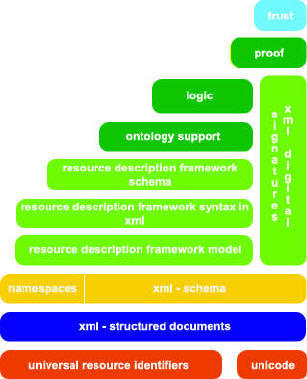Semantics: Semantic Networks and the Semantic Web
Definition: A semantic network is a knowledge representation tool consisting of a framework of
semantically related terms, with the purpose of allowing a definition of those words
through their relationships.
The Semantic Web is a project intended to convert the World Wide Web into a universal
semantic network through the use of markup languages and advanced
metadata, allowing the
Internet to become machine-readable in order to
enhance the knowledge management of computers.
Information has always played a vital role in the success or failure of an enterprise.
From the smallest one-man enterprise to the largest multinational, the importance of
business intelligence cannot be overstated.
 The simple possession of information, however, is not enough to ensure
business
intelligence. Much more important is the ability to convert that information into
valuable data, to allow it to be used in the formation of
strategies. The simple possession of information, however, is not enough to ensure
business
intelligence. Much more important is the ability to convert that information into
valuable data, to allow it to be used in the formation of
strategies.
Enterprises collect vast amounts of commercial data every day, from customer
feedback and market research to sales data and
supply chain information. Unfortunately,
it isn’t possible for an enterprise to devote the resources to study all of this data
closely (and, even if they could, it would be out of date by the time they had finished).
It is vital, therefore, that enterprises have some method of analysing data quickly
efficiently so as to highlight patterns and trends that may be useful in the achievement
of their objectives.
Semantic Networks
Semantic networks can be invaluable tools in allowing enterprises to quickly convert
these vast volumes of information into
valuable data (see
John F Sowa’s article on
semantic networks for reference).
Essentially, a computer-based semantic network uses metadata (data describing data) in
order to accurately discern the meaning of information. Without metadata it is impossible
for a computer to understand what information means, which severely hampers its ability to
manage and serve up valuable data to the user.
 The benefits of semantic networks in business are plain to see. By allowing computers a
method of recognising the meaning of data held within a
data warehouse (or other information
storage medium), our computer searches for specific information become immeasurably more effective. The benefits of semantic networks in business are plain to see. By allowing computers a
method of recognising the meaning of data held within a
data warehouse (or other information
storage medium), our computer searches for specific information become immeasurably more effective.
Content management systems equipped to support such standards as Extensible Markup
Language (XML) and Resource Description Framework (RDF) are able to sort through vast
amounts of data automatically, recognising relationships between information and presenting
high-quality, relevant data to the user on demand.
An additional benefit of semantic networks in content management is that fact that the sum
total of data held within an organisation can be held centrally. When all data is assigned
standardised semantic metadata there is no need to store data outside the corporate database.
Instead, all data can be
stored in a single, inexpensive and easy to manage database to be
used by any application.
This approach also lends itself to data integration. There are often problems faced by
content management professionals in finding solutions to the problems posed by incompatible
data infrastructures. If one department names its products ‘product_name’ while another
uses ‘product_description’ there can be problems with compatibility. However, by standardising
both datasets using RDF metadata it becomes possible to combine the data from those datasets
and put them to good use.
The Semantic Web
The Internet is the largest repository of information on earth. Potentially, this data
can be of enormous value to enterprises. However, in reality valuable information often
proves difficult to find. At present we are limited to performing searches for information
that contains specific words. However, there is no guarantee that this will provide us with
useful information.
The Semantic Web aims to transform the way we find information stored on the Internet.
Rather than search for information containing our targeted keywords we will be able to
search the semantic meaning of the content, allowing search engines to return vastly more
targeted information to us.
Enterprises can also benefit from the semantic web from their own websites. By adopting a
semantic model on a corporate website it becomes possible to provide the customer with the
information they want. Websites built using semantic metadata can recognise synonyms, so
they are more flexible and intuitive that typical syntactic sites.
For example, if the enterprise sells bicycles, performing a product search for ‘mountain bike’
may present no results using a syntactic model, as the website may lack a section
titled ‘Mountain Bikes’. A semantic site, however, would recognise the connection
between ‘mountain bike’ and their product section titled ‘Off-road bicycles’, and
would direct the user towards the appropriate section.
|
 The simple possession of information, however, is not enough to ensure
The simple possession of information, however, is not enough to ensure
 The benefits of semantic networks in business are plain to see. By allowing computers a
method of recognising the meaning of data held within a
The benefits of semantic networks in business are plain to see. By allowing computers a
method of recognising the meaning of data held within a